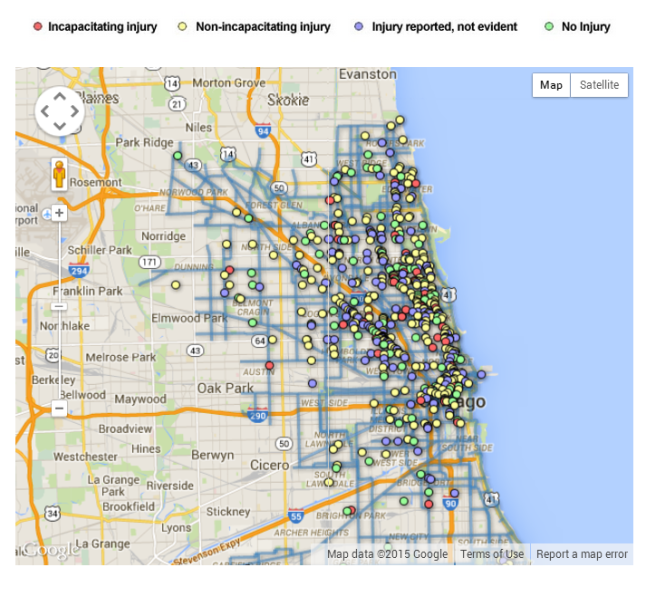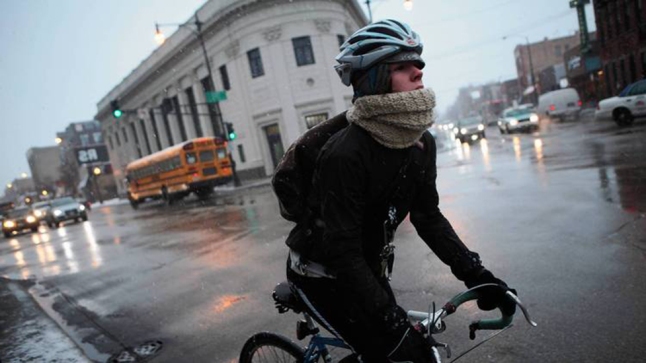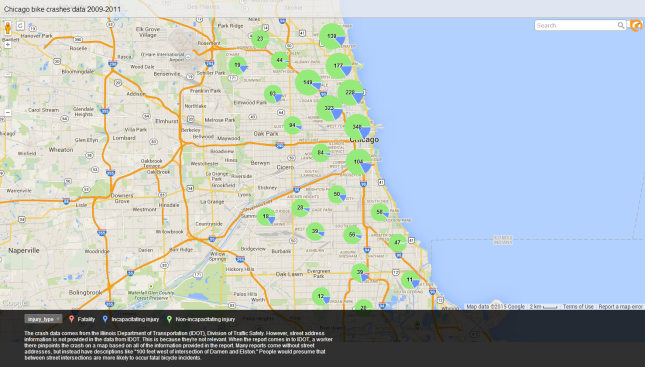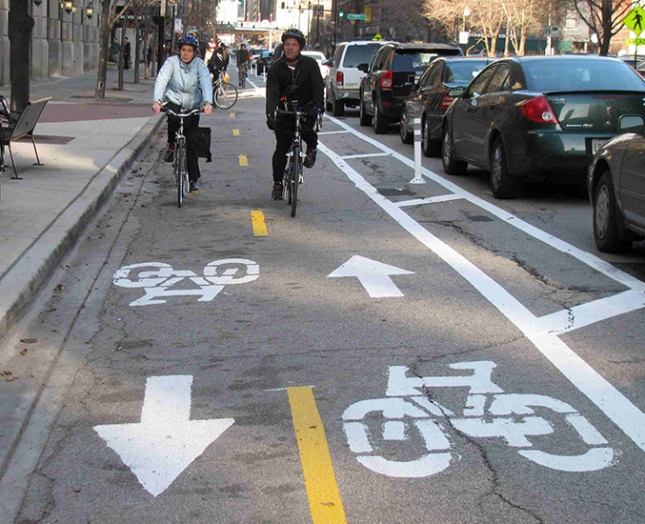Video Exercise
Ride Unsafe: the Story of Dooring
According to new bicycle crash data from the Chicago Department of Transportation, Downtown streets are the most dangerous roads for Chicago bikers because these streets have the most accidents. This might not be the case as they have more cycle traffic at the same time.
By Cheng Sun
CHICAGO – It is just another ordinary morning for Depaul University student Caiwei to climb on his bike and ride along N Clark Street to school.
The blizzard happened yesterday was unexpected, some automobiles are still stuck in the deep snow near sidewalk.
The Bike lane has been shoveled clear, for the most part.
Caiwei stops at the traffic light between W Fullerton Ave and N Clark St when a car next to him suddenly open the door and almost hit him.
“The driver did not see me.” said Caiwei afterwards, “I often see drivers who are totally oblivious to bikes. They open doors without looking, they pull in front of bikes with abandon, they don’t see bicycles because they haven’t accepted that cycling is part of our transportation system now. They haven’t figured out that we have become a city of peddlers – and that is a good thing.”
Caiwei was lucky, but there are people who are not.
Reality
The U.S. census tracks those who commute to work by bike, and in Chicago that number has grown steadily over the past 15 years, according to a 2012 analysis of city data published by the Department of Transportation.
The city didn’t have the final 2014 statistics showing the total number of cyclists injured in crashes with vehicles. But the numbers have increased in the past three years, from little more than 1,300 in 2011 to more than 1,500 in 2013, according to data provided by the city.
View Chicago bike crashes data 2009-2011 in a full screen map
Dooring
The term “dooring” applies to incidents in which the cyclists is riding in a legal space and a person in a stationary vehicle opens their door causing a crash. (City of Chicago, Bicycle Crash analysis)
Below is a chart of where and under what circumstances Dooring are taking place.
 The observation is pretty clear. There are large pockets of Dooring accidents on primary diagonal streets and intersections that serve the loop area, particularly Milwaukee and Lincoln Avenues, as well as on Clark Street. Which is the same pattern as shown in the 2009-2011 Chicago Bike Crashes Data map.
The observation is pretty clear. There are large pockets of Dooring accidents on primary diagonal streets and intersections that serve the loop area, particularly Milwaukee and Lincoln Avenues, as well as on Clark Street. Which is the same pattern as shown in the 2009-2011 Chicago Bike Crashes Data map.
The Bike Lane
“These Dooring crashes can lead to very serious injuries.” Said Bicycle House Tallahassee owner Scott Benton, who was recovered from a coma caused by a bike accident couple years ago.
“Practical transportation means it is the most efficient way for daily commute. Cyclists, in this sense, should be more careful when they are riding in the traffic.”
“Of course the bike lane is important.” Scott added as he pointed at his computer screen. “But it should be well placed, to protect and benefit the cyclists”
Unfortunately, most of the bike lanes in Chicago and other major cities across America are striped lanes sandwiched between a lane of traffic and a lane of parked cars. Not as ideal as he thinks.
The Grid‘s Steven Vance argues that the Second City “must stop building narrow bike lanes to the left of parked cars,” and instead focus on building the kind of “buffered” bike lanes Chicago installed on sections of Elston, Kinzie and 18th street.
“For a great example on why I cannot – and why you should not support bad road designs is every story of fatal bike crashes on a major biking “Commuterway” in Chicago.” Said Steven Vance in his blog.
Crash Reduction Strategies
“We believe the only acceptable number of fatalities is zero.” Said Jim Merrell, an advocacy campaign director for the Active Transportation Alliance.
Merrell pointed to the Dearborn Street bike lane and the Milwaukee Avenue bike lane, where in some areas cyclists and cars are separated by white poles called “bollards” as examples of streets in Chicago where the well installation of protected bike lanes has been making commuters feel safer and reduce collisions.
Mayor Rahm Emanuel said he aims to build 100 miles of protected bike lanes and increase fines for cyclists committing traffic violations and for motorists who open their doors in the path of cyclists.
audio exercise

Photo Exercise
Chicago crime statistics doubts adding up
The city’s inspector general, Joseph Ferguson, finalized an audit of the Chicago police department’s 2012 crime data to determine if CPD reported related crime statistics correctly.
From 2010 to 2013, Chicago’s annual “index crimes” dropped a stunning 56 percent, or nearly 19 percent per year, according to data from the Chicago Police Department. Yet, from 1993 to 2010, it dropped by 47 percent.
“The reduction in crime since Police Superintendent Garry McCarthy arrived in May 2011 is unbelievable”, said some of his detractors.
The superintendent was then suspected to accomplish this huge reduction in part by changing how certain crimes are categorized. The audit is to determine if CPD accurately classified crimes under its written guidelines.
The curious cases of 2013
On the night of December 27, a 40 years old alleged gang members named Nathaniel Jackson was shot in the head and killed in Austin. The next morning, newscasters proclaimed that Chicago’s murder toll for the year had hit 500- a grim milestone last reached in 2008, during the Great Recession.
By lunchtime, the police department’s spinmeisters at 35th and Michigan had challenged the reports. The actual total, they said, was 499. A murder case earlier in the year had just been reclassified as a death investigation.
That’s just one example of the by-product of the highly regarded crime tracking program.
The CompStat system
Inaccuracies are hardly a Chicago-specific phenomenon. In the recent past, police departments in many other big cities have admitted to fudging the numbers. Each of those cases can be tracked to the pressures of various versions of one system: CompStat.
Former John Jay College of Criminal Justice professor Eli Silverman and Molloy College professor John Eterno believe CompStat has undermined the reliability of American crime reporting system.
“Those people in the CompStat era felt less pressure to maintain the integrity of the crime statistics,” Eterno told the New York Times.
While on the other hand, Jack Maple, the founding father of the system argued that ComStat should have full credit for the dramatic decline in crime rates.
“ It is ludicrous to suggest that a department where the top brass did not even get crime data until six months after the crime and then did nothing with them—as was the case in the pre-CompStat era – cared more about the accuracy of crime statistics than one in which every deployment decision is made based on the minute-by-minute reality of crime on the streets.” Said Jack in one of his interviews.
The magic ink
Relying on the anonymous responses of hundreds of retired high-ranking police officials, a survey found that tremendous pressure to reduce crime, year after year, prompted some supervisors and precinct commanders to distort crime statistics. One detective refers to the “magic ink”: the power to make a case disappear.
So who should blame, the system or the people.
“Because the current Chicago Police Department culture is built on a wink-and-nod axiom that crime must only go down—and because careers are made or broken by good or bad “performance”—pressure to reduce crime numbers in this way has become acute at all levels.”Says the Chicago Magazine’s report on The Truth About Chicago’s Crime Rates.
2010-2013 Chicago homicide not solved












